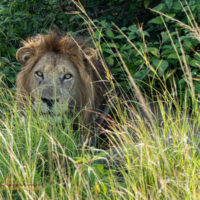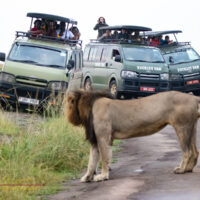Lions are a big deal around Queen Elizabeth National Park, one of the reliable places to see them. A couple well known prides maintian territories that are quite accessible to the safari tours, making the park a must for the usual package safari tours.
These typical tours advertise a three or five day tour of Uganda’s wildlife, making a whirlwind tour of western Uganda and the various parks. They may stop at Bwindi NP to view the gorillas, Kibale NP for the chipanzees, and Queen Elizabeth NP for the lions.
Perusing the many online safari advertisements it becomes apparent that top billing in Uganda goes to the gorillas, nearly every tour package highlighting the primates. Gorillas may be the goal of foreign travelers, but for local tourists, most from Uganda or other East African countries, it is the lions they come to see. For those who grew up here it is the lions that hold the fascination and mystique.
Lions are a big deal around Queen Elizabeth National Park. Every tour wants to find them, and when found every van or range rover in the park quickly heads to the location.
As this was my first time to Africa I was happy to see the basics… Antelope, buffalo, hippos, and elephants… The park would supply these in numbers that were rather surprising and enjoyable. I had made a deliberate decision to avoid the gorilla tours that everyone wanted to sell me. Opting instead for a relaxed five nights in the same place instead of the frantic tour across half a country.
Thus I was not really concerned that we had not seen lions during the first couple safari drives despite my guide’s efforts to find them. Actually no one had seen them. There had been no good lion sightings for days, apparently the pride had moved a bit deeper into the brush away from the accessible tracks.
Sulait, my guide had suggested we give it another try with an early start. Just one pass through the most likely road in the park, then on to the crater drive we had already planned for the day. His plan worked.
We were just bumping along the road fruitlessly when his phone beeped yet again. As he chatted I heard “Simba” several times, the conversation was about lions. As only the second vehicle to enter the park that morning I was surprised, there were not yet a lot of eyes looking for the lions, but Sulait was one of the first called when they were seen.
We turned around quickly and bounced down a couple kilometers of the muddy dirt tracks left by the fading rainy season.
Sure enough, lying in the middle of the road was a lion.



We were the second vehicle on site and had our pick of where to park, just a stone’s toss in front of a rather indifferent lion. He gazed at us, and as quickly dismissed us as uninteresting. This lion was obviously used to the routine, the jaded star of the show who had seen it all before.
I could take all the photos I wanted, and did. Besides giving off an unmistakable air of indifference the lion also reminded us that it was still a cat. The lion yawned like a cat, groomed like a cat, and generally acted like a cat. We just sat while enjoying the view, and took a few more photos.
When more and more safari vehicles arrived it became a bit much for even this old jaded lion. He got up, paused to glare at the arriving vans of tourists, and wandered off into the deep grass and brush before dropping down again to resume an interrupted nap. You could still see him, but not nearly as well and more distant. Time to go.
As we departed to head for the craters as planned the traffic continued. We passed another half dozen vans loaded with tourists headed quickly the other way, all heading for the reported lion.
We would go on to see lions a couple more times before my days were up. A pair of lionesses relaxing in the low branches of a tree one time, a bit distant from the road for good photos, but clearly visible. We also found the same older male a second time on the last day, the scars on his nose making it clear he was the same cat. Lions are a big deal around Queen Elizabeth National Park.



